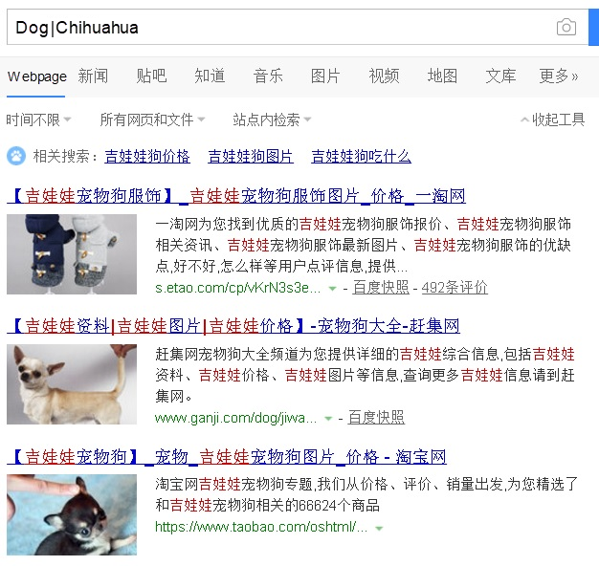Let us start with two examples to understand how does the rank calculation work on PostgreSQL.
The following two records are available in the database.
"I want a dog" // 狗
"I want a chihuahua" // 吉娃娃狗 Use the following query condition and run a query.
"dog|chihuahua" Clearly, both records match. However, the question here is which one should be displayed at the top?
Now, search for "dog|chihuahua" in the search engine and see which record will be displayed at the top? Skip to the second page to avoid advertisements.

As shown in the preceding snapshot, records about Chihuahua are displayed first. You may ask, why?
It is due to the term frequency-inverse document frequency (TF-IDF) algorithm. In a global text, the occurrence frequency of the word dog is higher than that of Chihuahua. Therefore, according to the inverse document frequency (IDF) algorithm, the IDF (log (total number of texts/number of texts containing the word)) of the word 'dog' is lower than that of 'Chihuahua'.
However, in case if TF is the same, the size of TF × IDF depends on the size of IDF. PostgreSQL databases support full-text search. But, do they support TF-IDF by default?
According to the code, the ts_rank and ts_rank_cd functions of PostgreSQL do not take IDF into consideration.
People across social forums are also asking the same question. You can read more about this here
Within the ts_rank function, there is no native method to rank results using their global (corpus) frequency. The rank algorithm does however rank based on frequency within the document:
http://www.postgresql.org/docs/9.3/static/textsearch-controls.html
So if I search for "dog|chihuahua" the following two documents would have the same rank despite the relatively lower frequency of the word "chihuahua":
"I want a dog" // 狗
"I want a chihuahua" // 奇瓦瓦狗
However, the following line would get ranked higher than the previous two lines above, because it contains the stemmed token "dog" twice in the document:
"dog lovers have an average of 1.5 dogs"
In short: higher term frequency(TF) within the document results in a higher rank, but a lower term frequency in the corpus has no impact.
One caveat: the text search does ignore stop-words, so you will not match on ultra high frequency words like "the","a","of","for" etc (assuming you have correctly set your language)
Postgres does not use TF-IDF as a similarity measure among documents.
ts_rank is higher if a document contains query terms more frequently. It does not take into account the global frequency of the term.
ts_rank_cd is higher if a document contains query terms closer together and more frequently. It does not take into account the global frequency of the term.
There is an extension from the text search creators called smlar, that lets you calculate the similarity between arrays using TF-IDF.
It also lets you turn tsvectors into arrays, and supports fast indexing.
PostgreSQL's built-in rank algorithm does not care about the IDF, instead only calculates the word frequency in the current text.
Currently, PostgreSQL uses ts_rank and ts_rank_cd to calculate the correlation between tsquery and tsvector. For more details about the algorithm, refer to the previous blog in this series Keyword Analysis with PostgreSQL: Cosine and Linear Correlation Algorithms for Text Analysis.
The smlar plug-in supports multiple similarity calculation formulas (algorithms), including cosine (default), TF-IDF, and overlap. It also allows you to customize a formula or function to calculate the similarity.
1. Calculate the similarity between arrays.
float4 smlar(anyarray, anyarray)
- computes similary of two arrays. Arrays should be the same type.
2. Calculate the similarity between custom composite arrays (elements and weights). You can select to calculate all elements or only the overlapped elements. When the weights are different, the similarity result is different, for example, in the cosine algorithm.
Alternatively, you can take the array as a weighted array that contains TD-IDF, such as [('China', 0.1), ('Japan ', 0.1), ('pirate', 0.9)]. It is useful for text similarity analysis.
float4 smlar(anyarray, anyarray, bool useIntersect)
- computes similary of two arrays of composite types. Composite type looks like:
CREATE TYPE type_name AS (element_name anytype, weight_name FLOAT4);
useIntersect option points to use only intersected elements in denominator
see an exmaples in sql/composite_int4.sql or sql/composite_text.sql
Consider the following example:
postgres=# create type tp as (c1 text, c2 float4);
CREATE TYPE
postgres=# select smlar(array[('你好',2.1), ('中国',1.1)]::_tp, array[('你好',2.1), ('中国',1.1),('china',1)]::_tp);
smlar
----------
0.816497
(1 row)
postgres=# select smlar(array[('你好',2.1), ('中国',1.1)]::_tp, array[('你好',2.1), ('中国',1.1),('china',1)]::_tp,true);
smlar
-------
1
(1 row)
postgres=# select smlar(array[('你好',2.1), ('中国',1.1)]::_tp, array[('你好',2.2), ('中国',1.1),('china',1)]::_tp,true);
smlar
----------
0.999822
(1 row)
与顺序无关
postgres=# select smlar(array[('你好',2.1), ('中国',1.1)]::_tp, array[('中国',1.1),('你好',2.2),('china',1)]::_tp,true);
smlar
----------
0.999822
(1 row)
Note: GiST doesn't support composite weighted type.
elog(ERROR, "GiST doesn't support composite (weighted) type");3. Use a custom formula that contains three variables, namely, N.i, N.a, and N.b, to calculate the similarity between arrays. You can also customize the algorithm.
float4 smlar( anyarray a, anyarray b, text formula );
- computes similary of two arrays by given formula, arrays should
be the same type.
Predefined variables in formula:
N.i - number of common elements in both array (intersection)
N.a - number of uniqueelements in first array
N.b - number of uniqueelements in second array
Example:
smlar('{1,4,6}'::int[], '{5,4,6}' )
smlar('{1,4,6}'::int[], '{5,4,6}', 'N.i / sqrt(N.a * N.b)' )
That calls are equivalent. Determine whether both arrays are similar. Note, when the similarity value is greater than the threshold, the threshold is specified by the smlar.threshold parameter).
anyarray % anyarray
- returns true if similarity of that arrays is greater than limit
float4 show_smlar_limit() - deprecated
- shows the limit for % operation
float4 set_smlar_limit(float4) - deprecated
- sets the limit for % operation
Use instead of show_smlar_limit/set_smlar_limit GUC variable
smlar.threshold (see below)
Follow the steps below to implement the conversion function API:
Step 1. Convert the tsvector-type data to the text array.
text[] tsvector2textarray(tsvector)
- transforms tsvector type to text array Step 2. Sort the elements in the array and remove repeated elements.
anyarray array_unique(anyarray)
- sort and unique array Step 3. Determine whether the array contains a specific element. If yes, 1.0 is returned. If not, 0 is returned.
float4 inarray(anyarray, anyelement)
- returns zero if second argument does not present in a first one
and 1.0 in opposite case Step 4. Similar to the ternary operator, determine whether the array contains a specific element. If yes, the value of the third parameter is returned. If not, the value of the fourth parameter is returned.
float4 inarray(anyarray, anyelement, float4, float4)
- returns fourth argument if second argument does not present in
a first one and third argument in opposite case Implement the following steps to set the parameters:
Step 1. Specify the similarity threshold. When the similarity is lower than the threshold, 'False' is returned for the % operator, which is used to calculate whether two arrays are similar.
smlar.threshold FLOAT
Array's with similarity lower than threshold are not similar
by % operation Step 2. Specify whether to persist in the IDF table.
smlar.persistent_cache BOOL
Cache of global stat is stored in transaction-independent memory Step 3. Specify the default similarity algorithm.
smlar.type STRING
Type of similarity formula: cosine(default), tfidf, overlap The preceding command is source code, where the IDF statistics table is used during TF-IDF calculation.
switch(getSmlType())
{
case ST_TFIDF:
PG_RETURN_FLOAT4( TFIDFSml(sa, sb) );
break;
case ST_COSINE:
{
int cnt;
double power;
power = ((double)(sa->nelems)) * ((double)(sb->nelems));
cnt = numOfIntersect(sa, sb);
PG_RETURN_FLOAT4( ((double)cnt) / sqrt( power ) );
}
break;
case ST_OVERLAP:
{
float4 res = (float4)numOfIntersect(sa, sb);
PG_RETURN_FLOAT4(res);
}
break;
default:
elog(ERROR,"Unsupported formula type of similarity");
}
For more information about algorithms, refer the document, Similarity Algorithms - Effective Similarity Search in PostgreSQL.
Step 4. If the similarity algorithm is TF-IDF, set this parameter and use a statistics table to record the IDF of each word and the total number of texts.
smlar.stattable STRING
Name of table stored set-wide statistic. Table should be
defined as
CREATE TABLE table_name (
value data_type UNIQUE, -- 词
ndoc int4 (or bigint) NOT NULL CHECK (ndoc>0) -- 该词一共出现在几个文本中
);
And row with null value means total number of documents.
See an examples in sql/*g.sql files
Note: used on for smlar.type = 'tfidf'
Step 5. If the similarity algorithm is TF-IDF, set this parameter as shown below. TF calculation method settings: frequency of occurrence, 1 + log (frequency of occurrence), and constant 1.
smlar.tf_method STRING
Calculation method for term frequency. Values:
"n" - simple counting of entries (default)
"log" - 1 + log(n)
"const" - TF is equal to 1
Note: used on for smlar.type = 'tfidf'
Note: GIN index supports only smlar.tf_method = "const""
Step 6. If the similarity algorithm is TF-IDF, set this parameter as below:
Whether to obtain the log by adding 1 to the IDF.
smlar.idf_plus_one BOOL
If false (default), calculate idf as log(d/df),
if true - as log(1+d/df)
Note: used on for smlar.type = 'tfidf'
Module provides several GUC variables smlar.threshold, it's highly
recommended to add to postgesql.conf:
custom_variable_classes = 'smlar' # list of custom variable class names
smlar.threshold = 0.6 #or any other value > 0 and < 1
and other smlar.* variables
The core function of the smlar plug-in is to calculate the similarity between arrays of any type. It also supports indexing to increase speed. The OPSs are required when you create an index. Different types of arrays are listed below for your reference:
GiST/GIN support for % and && operations for:
Array Type | GIN operator class | GiST operator class
---------------+----------------------+----------------------
bit[] | _bit_sml_ops |
bytea[] | _bytea_sml_ops | _bytea_sml_ops
char[] | _char_sml_ops | _char_sml_ops
cidr[] | _cidr_sml_ops | _cidr_sml_ops
date[] | _date_sml_ops | _date_sml_ops
float4[] | _float4_sml_ops | _float4_sml_ops
float8[] | _float8_sml_ops | _float8_sml_ops
inet[] | _inet_sml_ops | _inet_sml_ops
int2[] | _int2_sml_ops | _int2_sml_ops
int4[] | _int4_sml_ops | _int4_sml_ops
int8[] | _int8_sml_ops | _int8_sml_ops
interval[] | _interval_sml_ops | _interval_sml_ops
macaddr[] | _macaddr_sml_ops | _macaddr_sml_ops
money[] | _money_sml_ops |
numeric[] | _numeric_sml_ops | _numeric_sml_ops
oid[] | _oid_sml_ops | _oid_sml_ops
text[] | _text_sml_ops | _text_sml_ops
time[] | _time_sml_ops | _time_sml_ops
timestamp[] | _timestamp_sml_ops | _timestamp_sml_ops
timestamptz[] | _timestamptz_sml_ops | _timestamptz_sml_ops
timetz[] | _timetz_sml_ops | _timetz_sml_ops
varbit[] | _varbit_sml_ops |
varchar[] | _varchar_sml_ops | _varchar_sml_ops
The following steps describes how to use TF-IDF.
Step 1. Install the smlar plug-in.
/* see http://blog.databasepatterns.com/2014/07/postgresql-install-smlar-extension.html */
create extension if not exists smlar;
Step 2. Now, create a test table.
/* your basic table to search against: */
create table documents (
document_id int primary key,
body text not null
);
Step 3. Import test data. You can visit this site and select to generate the test data.
/*
I created 100,000 "lorem ipsum" documents here http://www.mockaroo.com/c5418bd0
In retrospect, not a great choice due to the small number of unique words used to generate the dataset
*/
copy documents
from program 'curl "http://www.mockaroo.com/c5418bd0/download?count=100000&key=5b15a410"'
with (format csv, header true);
Or execute the following commands:
copy documents
from '/home/digoal/test.csv'
with (format csv, header true);
Step 4. Create a statistical table to record the number of texts that contain each word and the total number of texts. For daily use, you can export phrases and IDF from the dictionary, generate the total number of texts and the occurrence frequency of words, and import the information to the table.
For example, you can import this information from SCWS, Jieba, and other dictionaries to the following table.
/* this table holds document frequencies (# of docs in which a term appears) for the documents.body column: */
create table documents_body_stats (
value text unique,
ndoc int not null
); Step 5. Use local data to generate IDF. You can skip this step in actual practice. It is recommended to import IDF from a dictionary.
/* used ts_stat for convenience, not ideal, but good for quick n dirty: */
insert into documents_body_stats
select
word,
ndoc
from
ts_stat( 'select to_tsvector(''simple'', body) from documents' );
Step 6. Now, insert the number of texts.
/* the smlar tfdif table needs the total document count as well. It's added as a row with null in the value column: */
insert into documents_body_stats values
(null, (select count(*) from documents) );
Step 7. Create a function that converts the text to a text array.
/* turn documents into array of words. you could also use tsvector2textarray( to_tsvector(...) ) : */
create or replace function tokenize(text) returns text[] language sql strict immutable as $$
select regexp_split_to_array( lower($1), '[^[:alnum:]]' );
$$;
Note: Duplicate values are lost when tsvector is converted to an array.
postgres=# select tsvector2textarray(to_tsvector('i am digoal digoal')), to_tsvector('i am digoal digoal');
tsvector2textarray | to_tsvector
--------------------+--------------
{digoal} | 'digoal':3,4
(1 row)
Step 8. Next, create an expression index.
/* use smlar's text array opclass. gist is a little more flexible than gin in this case (allows 'n' tf_method): */
create index on documents using gist ( tokenize(body) _text_sml_ops ); --24 seconds
Step 9. Set parameters and use the TF-IDF formula to calculate the array similarity.
/* setup smlar: */
set smlar.type = 'tfidf';
set smlar.stattable = 'documents_body_stats';
set smlar.tf_method = 'n';
set smlar.threshold = 0.4;
Step 10. Lastly, query the records. When the TF-IDF similarity is equal to or greater than the value of smlar.threshold, records are returned.
/* the query */
select
*,
smlar( tokenize(body), '{fringilla,malesuada,euismod}'::text[] )
from
documents
where
tokenize(body) % '{fringilla,malesuada,euismod}'::text[] -- where TFIDF similarity >= smlar.threshold
order by
smlar( tokenize(body), '{fringilla,malesuada,euismod}'::text[] ) desc
limit 10;
postgres=# explain (analyze,verbose,timing,costs,buffers) select
*,
smlar( tokenize(body), '{fringilla,malesuada,euismod}'::text[] )
from
documents
where
tokenize(body) % '{fringilla,malesuada,euismod}'::text[] -- where TFIDF similarity >= smlar.threshold
order by
smlar( tokenize(body), '{fringilla,malesuada,euismod}'::text[] ) desc
limit 10;
QUERY PLAN
-------------------------------------------------------------------------------------------------------------------------------------------------------
Limit (cost=2.18..2.18 rows=1 width=237) (actual time=7.647..7.647 rows=0 loops=1)
Output: document_id, body, (smlar(regexp_split_to_array(lower(body), '[^[:alnum:]]'::text), '{fringilla,malesuada,euismod}'::text[]))
Buffers: shared hit=79
-> Sort (cost=2.18..2.18 rows=1 width=237) (actual time=7.647..7.647 rows=0 loops=1)
Output: document_id, body, (smlar(regexp_split_to_array(lower(body), '[^[:alnum:]]'::text), '{fringilla,malesuada,euismod}'::text[]))
Sort Key: (smlar(regexp_split_to_array(lower(documents.body), '[^[:alnum:]]'::text), '{fringilla,malesuada,euismod}'::text[])) DESC
Sort Method: quicksort Memory: 25kB
Buffers: shared hit=79
-> Index Scan using documents_tokenize_idx on public.documents (cost=0.14..2.17 rows=1 width=237) (actual time=7.641..7.641 rows=0 loops=1)
Output: document_id, body, smlar(regexp_split_to_array(lower(body), '[^[:alnum:]]'::text), '{fringilla,malesuada,euismod}'::text[])
Index Cond: (regexp_split_to_array(lower(documents.body), '[^[:alnum:]]'::text) % '{fringilla,malesuada,euismod}'::text[])
Rows Removed by Index Recheck: 61
Buffers: shared hit=79
Planning time: 0.148 ms
Execution time: 7.703 ms
(15 rows)
You can increase the similarity threshold to exclude more records and improve query efficiency.
postgres=# set smlar.threshold = 0.8;
SET
postgres=# explain (analyze,verbose,timing,costs,buffers) select
*,
smlar( tokenize(body), '{fringilla,malesuada,euismod}'::text[] )
from
documents
where
tokenize(body) % '{fringilla,malesuada,euismod}'::text[] -- where TFIDF similarity >= smlar.threshold
order by
smlar( tokenize(body), '{fringilla,malesuada,euismod}'::text[] ) desc
limit 10;
QUERY PLAN
-------------------------------------------------------------------------------------------------------------------------------------------------------
Limit (cost=2.18..2.18 rows=1 width=237) (actual time=1.051..1.051 rows=0 loops=1)
Output: document_id, body, (smlar(regexp_split_to_array(lower(body), '[^[:alnum:]]'::text), '{fringilla,malesuada,euismod}'::text[]))
Buffers: shared hit=29
-> Sort (cost=2.18..2.18 rows=1 width=237) (actual time=1.049..1.049 rows=0 loops=1)
Output: document_id, body, (smlar(regexp_split_to_array(lower(body), '[^[:alnum:]]'::text), '{fringilla,malesuada,euismod}'::text[]))
Sort Key: (smlar(regexp_split_to_array(lower(documents.body), '[^[:alnum:]]'::text), '{fringilla,malesuada,euismod}'::text[])) DESC
Sort Method: quicksort Memory: 25kB
Buffers: shared hit=29
-> Index Scan using documents_tokenize_idx on public.documents (cost=0.14..2.17 rows=1 width=237) (actual time=1.042..1.042 rows=0 loops=1)
Output: document_id, body, smlar(regexp_split_to_array(lower(body), '[^[:alnum:]]'::text), '{fringilla,malesuada,euismod}'::text[])
Index Cond: (regexp_split_to_array(lower(documents.body), '[^[:alnum:]]'::text) % '{fringilla,malesuada,euismod}'::text[])
Rows Removed by Index Recheck: 1
Buffers: shared hit=29
Planning time: 0.190 ms
Execution time: 1.113 ms
(15 rows)
如果你不需要对结果按相似度排序的话,也可以把order by去掉,提升性能。
Basic steps for clustering documents may vary a bit depending on your specific goals. However, the following example shows a standard scenario:
Next, build feature vectors for each document. There are a variety of methods for handling this, one common example would be to build tf-idfs. For this, you need the following metrics:
Given a tf-idf feature vector, the most common distance function is cosine similarity, though other distance functionsmay make sense depending on your use case. RUM also supports TF-IDF.
Build your own PostgreSQL solution on Alibaba Cloud with ApsaraDB for RDS PostgreSQL.
Keyword Analysis with PostgreSQL: Algorithms for Text Analysis with RUM and Smlar
Keyword Analysis with PostgreSQL: Cosine and Linear Correlation Algorithms for Text Analysis
digoal - February 5, 2020
digoal - February 3, 2020
digoal - February 3, 2020
digoal - February 3, 2020
digoal - February 5, 2020
digoal - February 5, 2020
 PolarDB for PostgreSQL
PolarDB for PostgreSQL
Alibaba Cloud PolarDB for PostgreSQL is an in-house relational database service 100% compatible with PostgreSQL and highly compatible with the Oracle syntax.
Learn More AnalyticDB for PostgreSQL
AnalyticDB for PostgreSQL
An online MPP warehousing service based on the Greenplum Database open source program
Learn More ApsaraDB RDS for PostgreSQL
ApsaraDB RDS for PostgreSQL
An on-demand database hosting service for PostgreSQL with automated monitoring, backup and disaster recovery capabilities
Learn More Database for FinTech Solution
Database for FinTech Solution
Leverage cloud-native database solutions dedicated for FinTech.
Learn MoreMore Posts by digoal